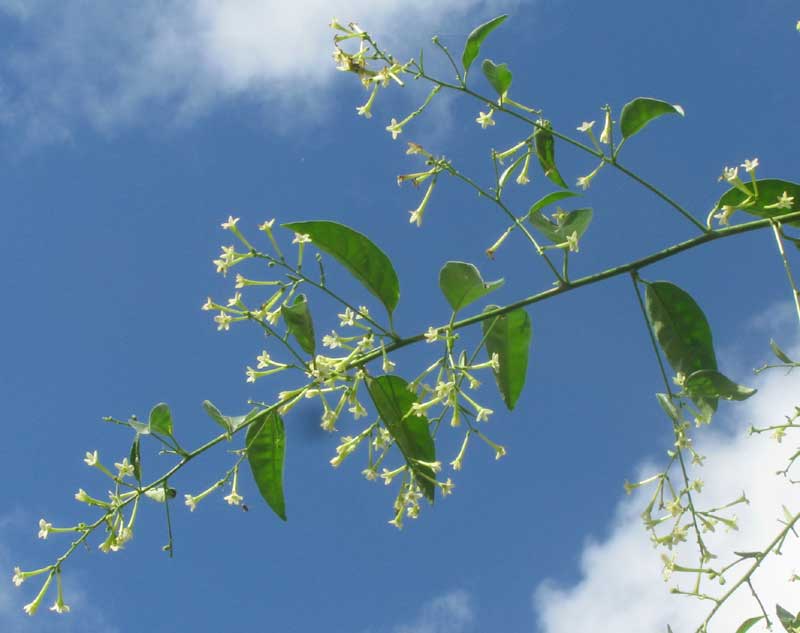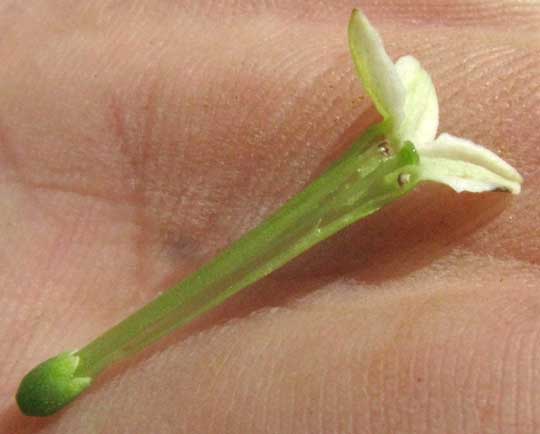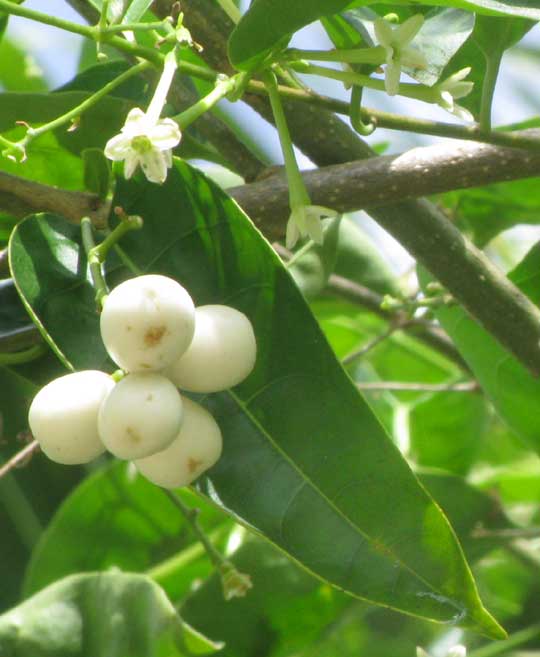Excerpts from Jim Conrad's
Naturalist Newsletter

from the February 12, 2012 Newsletter issued from Hacienda Chichen Resort beside Chichén Itzá Ruins; limestone bedrock; elevation ~39m (~128ft), N20.675°, W88.569°; central Yucatán state, MÉXICO
LADY OF THE NIGHT
On a late Sunday morning in backstreet Pisté I biked by the plain-looking, dense, shrubby tree neatly trimmed with a gated arch through it shown below:

I'd not seen such a planting before so I circled back, parked the bike, looked up, and saw what's shown at the top of this page. The leaves were about 2.4 inches long (6cm) and the flowers about ¾ inch long (2cm). Dissecting a flower I found five stamens attached near the mouth of the corolla tube's throat, with an expanded stigma atop a long, slender style, as a longitudinal section shows below:

The blossom was structured like a Tobacco flower, or even a Pepper flower, so I began suspecting that we had a member of, the Nightshade Family, or Solanaceae. That suspicion grew when I saw the fruits shown below:

The fruits were like seedy little tomatoes, and the Tomato plant also belongs to the Nightshade Family.
After I'd "done my botany" awhile I started feeling watched. I looked up and at the thatch-roofed hut next door sat two middle-aged ladies with more babies and starved dogs around them than I could register, wide-eyed and smiling broadly. I laughed, explained that this sure was an interesting tree, and asked if they had a name for it:
"Galán de Noche," they said in unison, a galán being a dashing lover or wooer and noche being night: "Night Lover." The ladies approached and the one with missing front teeth said:
"In the night, all up and down this street... " she gestured down the potholed lane with kids here and there peeping over stone walls and around house corners, and I could visualize what it must be like in the night, the huts' one-lightbulb lights, the barking dogs, the odors of wood fires and dog and baby poop... "... the perfume... " she continued, clutching at her heart and theatrically rolling her eyes up in her head.
And then I smelled it, too, even then in late morning with the tree downwind, yes, sweeter and more dizzying than orange blossoms or honeysuckles, a kind of fragrance that flips the guts and reminds you that you have to die and then there won't be fragrances like this...
On the Internet the small tree was easy to identify because the species is famous and much planted in the world tropics precisely because it smells so good in the night. It's CESTRUM NOCTURNUM, and that's an old Linnaeus name, so it's been called that that for a long time, and since nocturnum means the night, you know that even stodgy Linnaeus when he named it back in 1753 knew about the special coupling of night and fragrance the lady had just told me about.
Cestrum nocturnum goes by lots of English names such as Night Blooming Jasmine, Queen of the Night, Night Jessamine, Lady of the Night and Bastard Jasmine. Despite all the references to Jasmine, Jasmine is something else entirely, in the Olive Family not the Nightshade. I've settled on the name Lady of the Night just because that's the mood you get in when you smell it.
Lady of the Night is native to the American tropics, including the Yucatán, though I've never seen it growing wild. In the Old World they grow it, too. In India and elsewhere in South Asia they use it for perfumery, medicinal applications and in religious ceremonies, though some parts of the plant are poisonous.
How amazing that an old codger can first experience such things in a town he's been through so many times without ever having noticed it!